
I’ve just seen the news on Facebook that historian and author David Baldwin passed away on Monday (4th April). It is such sad news.
[Read More...]
I’ve just seen the news on Facebook that historian and author David Baldwin passed away on Monday (4th April). It is such sad news.
[Read More...]
This month’s amazing Expert Talk is by Stephanie Mann, author of “Supremacy and Survival”. Her topic, one which is clearly close to her heart, is Thomas More, a fascinating man who it turns out we really don’t know as much about as we should.
[Read More...]
Today’s Tudor history quiz consists of ten questions about “how long”?
Test your Tudor history knowledge with this fun quiz – good luck!
[Read More...]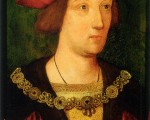
On 2nd April 1502, Arthur Tudor, eldest son of King Henry VII, died at Ludlow Castle. He was just fifteen years old and had been married for less than five months.
Arthur Tudor had married Katherine of Aragon, daughter of King Ferdinand II of Aragon and Queen Isabella I of Castile. King Henry VII had worked hard for several years to secure a marriage between his son and Princess Katherine to see a strong alliance created between England and Spain. The marriage would also help to put England on the international stage and secure the succession of the Tudors.
[Read More...]
In today’s Claire Chats I talk about all the issues to do with the calendar and dating of documents and sources which are just waiting to catch you out!
[Read More...]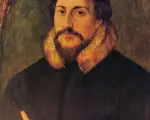
The Huguenots were French Protestants, formed as a part of the general Reformation that started in Germany because of Martin Luther and swept through the Continent. It hit France around 1517, where the movement quickly grew in popularity. The movement was particularly popular in French areas where the population was unhappy with the government or areas that were experiencing economic hardship. The name “Huguenot” is of uncertain origin; some believe the Huguenots are named after Besançon Hugues, leader of the movement in Geneva, Switzerland. Another possibility finds its roots in the German word Eidgenossen, meaning confederates bound by oath, which became aignos in France and referred to patriots living in Geneva who were against the Duke of Savoy during 1520 to 1524. In August 1523, the first martyr, Jean Vallière, was burnt at the stake.
[Read More...]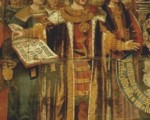
Thank you to Melanie V. Taylor, our art historian, for spotting and sharing with me this interesting article on the beautiful Chichester Cathedral Tudor Paintings by Lambert Barnard (c1435 – 1567) which include this image of Henry VIII which I’ve never seen before.
[Read More...]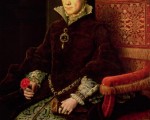
On 30th March 1558, Queen Mary I made her last will and testament, believing that she would soon give birth and knowing that childbirth was a risky process.
[Read More...]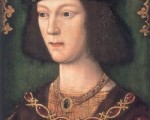
A fun quiz for Easter weekend! Who is being described in the following contemporary descriptions? Can you figure it out?
[Read More...]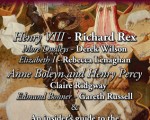
Packed with a wide range of articles about Tudor personalities like the Dudleys, Elizabeth of York, Mary I, Isabella of Spain and Henry Howard. There is part one of an insider’s guide to the Tower of London, a detailed article about Greenwich Palace and Wroxhall Abbey, an article about some bizarre Tudor foods and lots more! It’s our best magazine yet!
[Read More...]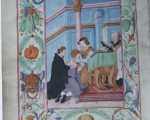
In today’s Claire Chats I look at the rituals associated with Good Friday in Tudor times and draw on the account of Mary I’s Good Friday service of 4th April 1556 to give us a clearer picture.
[Read More...]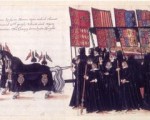
“It is not my desire to live or to reign longer than my life and my reign shall be for your good,” said Elizabeth to her parliament in 1601. Upon one of the many times parliament questioned Elizabeth about her plan of succession, she stated, “I know I am but mortal and so therewhilst prepare myself for death, whensoever it shall please God to send it.” And send it, God eventually did.
24 March, 1603. Elizabeth I, the Virgin Queen, England’s Gloriana and daughter of the great Henry VIII by the ill-fated Anne Boleyn, passed away peacefully in her sleep at Richmond Palace. She was 69 years old and had reigned for almost 45 years.
[Read More...]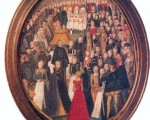
Maundy Thursday commemorates the Last Supper, that final meal that Jesus Christ had with his disciples before his arrest.
In Tudor times, on Maundy Thursday, the church was prepared for Easter with water and wine being used to wash the altars and it was traditional for people to go to confession. The three holy oils – the chrism oil, the oil of catechumens and the oil of the sick – were also blessed on this day.
At the Last Supper, which was the Passover meal, Luke’s Gospel says that Christ took bread, gave thanks to God for it, broke it and then shared it with his disciples, saying “This is my body given for you; do this in remembrance of me.” He then took the cup of wine, saying, “This cup is the new covenant in my blood, which is poured out for you.” Christians all over the world remember this gesture by celebrating the Eucharist, also known as “communion”. According to John’s Gospel, it was at this meal that Jesus washed his disciples’ feet, and both Luke and John record Jesus saying that there was one among them who would betray him.
[Read More...]
As this MadeGlobal Publishing promotion includes books by Tudor Society contributors and members, plus I know many of you enjoy historical fiction, I thought I’d share this news here.
MadeGlobal Publishing’s fiction books are on offer as Kindle Countdown Deals on Amazon.com and Amazon UK from 1am on 23rd March until 11pm on 24th March.
[Read More...]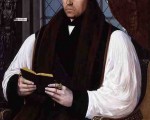
Today is the anniversary of Thomas Cranmer’s execution on 21st March 1556, when he was burned at the stake in Oxford for heresy. Here is a list of articles from the Tudor Society and the Anne Boleyn Files about this Oxford Martyr.
[Read More...]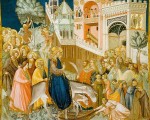
As Holy Week starts today I thought it was appropriate to have a fun quiz testing your knowledge of how this week was commemorated in medieval and Tudor times. I hope you enjoy this little quiz – good luck!
[Read More...]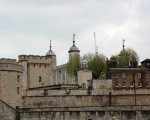
On Palm Sunday 1554 (which was 18 March that year), the twenty year old Elizabeth was taken to the Tower of London, the place where her mother had been imprisoned and where her mother and one of her stepmothers had been executed.
We can only imagine the sheer terror she felt when Mary I’s council turned up at her doorstep on the 16th March to formally charge her with being involved in Wyatt’s Rebellion, the revolt which had taken place in January and February 1554. Elizabeth was told that Mary wanted her sister taken to the Tower for questioning and that she would be escorted there the next day.
[Read More...]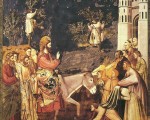
Palm Sunday is the sixth Sunday in Lent and marks the start of Holy Week. It commemorates the triumphal entry of Jesus Christ into Jerusalem on a donkey the week before the Resurrection. It is an event which features in the Gospels of Matthew, Mark, Luke and John, and here it is from John:
[Read More...]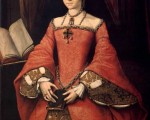
On 17th March 1554, two of Mary I’s councillors, Winchester and Sussex, were sent to escort Elizabeth, daughter of Henry VIII and Anne Boleyn, to her prison at the Tower of London by water for her alleged involvement in Wyatt’s Rebellion. This was when Elizabeth wrote what David Starkey calls “the letter of her life”, the famous Tide Letter, so-called because as Elizabeth wrote this letter to her sister the tide turned, making it impossible to take Elizabeth to the Tower that day.
The letter was written in haste but Elizabeth still managed to write an eloquent and well-argued letter, which unfortunately went ignored by Mary. It did, however, delay her imprisonment by one day.
[Read More...]
One of my favourite comfort foods is rice pudding so I decided to look through my medieval and Tudor recipe books for a 15th/16th century version. Unfortunately, what was known as a “pudding” back then was food cooked in animal intestines, i.e. sausage skins, like black pudding and sasages today. In Peter Brears’ book Cooking and Dining in Tudor and Stuart England, he gives a recipe for “Rice Puddings” which involves packing cooked rice mixed with milk, mace, suet, currants, nutmeg and cinnamon into sausage skins and boiling.
After doing some more digging, I then found that a rice in almond milk recipe was included in a manuscript from the 15th century and that various websites had modernised it for use today. The original recipe reads:
[Read More...]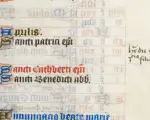
On 18th March 1496, Queen Elizabeth of York, wife of King Henry VII, gave birth to a healthy baby girl at Richmond Palace. The little girl was named Mary and her birth was recorded by Elizabeth in her Psalter. Lady Margaret Beaufort, the King’s mother, also recorded Mary’s birth in her Book of Hours. On 18th March, Margaret recorded: “Hodie nata Maria tertia filia Henricis VII 1495”, or “Today, ws born Mary, the third daughter of Henry VII 1495.” Although Margaret recorded the date as 1495, this is because the new calendar year did not start in Tudor times until Lady Day, 25th March, so we’d say that she was born in 1496.
[Read More...]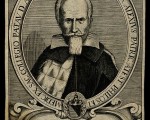
On 17th March 1565, Alexander Ales (also known as Alesius and Aless), theologian and reformer, died in Edinburgh, Scotland.*
Alexander Ales was born Alexander Allane or Alan at Edinburgh on 23 April 1500. From the age of twelve he was educated at the University of St Andrews, at St Leonard’s College, graduating BA after three years there. Ales became friends with theologian Philip Melancthon in 1532 when Ales began studying at Wittenberg University, and he began to be concerned with making the Bible available in the vernacular. He published an open letter to James V of Scotland in 1533, Alexandri Alesii epistola contra decretum quoddam episcoporum in Scotia, appealing for him to annul recent legislation making it illegal to own or distribute the New Testament in the vernacular. When the Catholic Johannes Cochlaeus, countered this with a letter to James accusing Ales of translating the New testament and sending it to Scotland, and claiming that it would cause unrest, Ales answered with Alexandri Alesii Scotti responsio ad Cochlei calumnias. In this letter, Ales emphasised how Continental reformers were simply trying to lead people back to the Bible and the teaching of the Early Church.
[Read More...]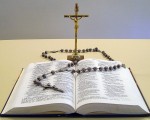
On this day in 1551, the Lady Mary ( the future Mary I), half-sister of King Edward VI, rode through London causing a stir. Here is diarist Henry Machyn’s record of the event:
“The xv day the Lady Mary rode through London unto St. John’s, her place, with fifty knights and gentlemen in velvet coats and chains of gold afore her, and after her iiij score gentlemen and ladies every one havyng a peyre of bedes of black. She rode through Chepe-syde and thrugh Smythfeld.”
[Read More...]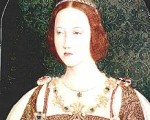
Test your knowledge on Mary Tudor, Queen of France and sister of King Henry VIII in this fun quiz.
[Read More...]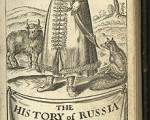
In today’s Claire Chats I talk about the life, career and legacy of Giles Fletcher the Elder, poet, diplomat and Member of Parliament.
[Read More...]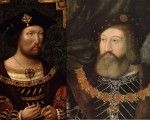
King Henry VIII held a great love of jousting. As a young teenager Henry had been denied the ability to joust in competitions as he was the sole heir to the throne. His father, Henry VII, feared his son may be injured or even worse killed. Yet when Henry came to the throne in 1509 he was extremely athletic and quickly took to the excitement and chivalry of the joust.
Throughout the early years of his reign Henry VIII participated in many fabulous jousting events, one of those being on 10th March 1524. However, the joust this day would not go as planned for the King and he faced a near disaster, one which could have ended his life.
[Read More...]